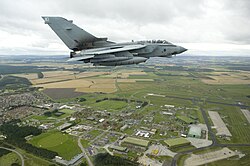RNAS Lossiemouth
| RAF Lossiemouth | |||||||||
|---|---|---|---|---|---|---|---|---|---|
| Near Lossiemouth, Moray in Scotland | |||||||||

A Tornado GR4 of 617 Squadron (Dambusters) over RAF Lossiemouth.
|
|||||||||

Thoir An Aire (Be Careful)
|
|||||||||
|
Shown within Moray
|
|||||||||
| Coordinates | 57°42′19″N 003°20′21″W / 57.70528°N 3.33917°WCoordinates: 57°42′19″N 003°20′21″W / 57.70528°N 3.33917°W | ||||||||
| Type | Royal Air Force station | ||||||||
| Site information | |||||||||
| Owner | Ministry of Defence | ||||||||
| Operator |
Royal Air Force 1939–1946 and 1972–Present Fleet Air Arm 1946–1972 |
||||||||
| Website | www |
||||||||
| Site history | |||||||||
| Built | 1938/9 | ||||||||
| In use | 1939–Present | ||||||||
| Garrison information | |||||||||
| Current commander |
Group Captain Paul Godfrey OBE MA RAF | ||||||||
| Occupants | |||||||||
| Airfield information | |||||||||
| Identifiers | IATA: LMO, ICAO: EGQS, WMO: 03068 | ||||||||
| Elevation | 13 metres (43 ft) AMSL | ||||||||
|
|||||||||
Royal Air Force 1939–1946 and 1972–Present
Royal Air Force Lossiemouth or more commonly RAF Lossiemouth or RAF Lossie (IATA: LMO, ICAO: EGQS) is a military airfield located on the western edge of the town of Lossiemouth in Moray, north-east Scotland.
Lossiemouth is one of the largest and busiest fast-jet stations in the Royal Air Force and known for its close proximity to flight training areas in Scotland and its favourable local flying conditions. It is now the only operational RAF station in Scotland and is one of two main operating bases for the Eurofighter Typhoon FGR4 in the United Kingdom. It is home to three front-line units which operate the Typhoon (No. 1 Squadron, No. 2 (AC) Squadron and No. 6 Squadron) each of which contribute to the Quick Reaction Alert (Interceptor) North capability which provides continuous protection of UK airspace.
The airfield opened in 1939 and was operated by the RAF, predominately as part of Bomber Command, until 1946 when it transferred to the Fleet Air Arm (FAA) and became known as RNAS Lossiemouth or HMS Fulmar. Lossiemouth was used as a training station by the FAA until it was handed back to the RAF in September 1972, after which it has largely operated as a fast-jet base.
Investment in infrastructure is planned at Lossiemouth in order to accommodate the RAFs new fleet of Boeing P-8A Poseidon aircraft, which are expected to enter service in 2020. A further squadron of Typhoons is expected to take up residence by April 2019.
Construction started during the summer of 1938, when 220 hectares of agricultural land was acquired in order to accommodate the airfield. The land was cleared of vegetation & buildings and by the spring of 1939 several wooden huts were present. Group Captain P.E Maitland AFC MVO was the first station commander and took up post in March 1939, with the station formally opening on 1 May 1939. The first unit to take up residence at Lossiemouth was No. 15 Flight Training School (FTS), initially equipped with thirteen Airspeed Oxfords and five Hawker Harts. Aircraft were stored in the open until the first hangars were completed in August 1939. That same month tragedy struck when three crew members were killed during a mid-air collision between two Oxfords.
...
Wikipedia

